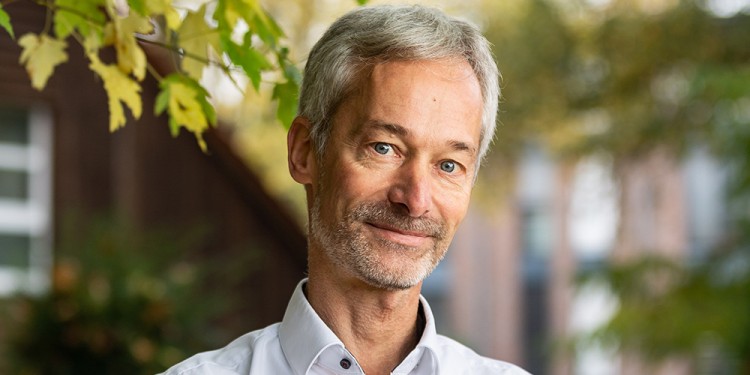
Fascinatin’ Rhythms
On Malmedyweg there is a building – between the University Hospital and the sports grounds, and set back a little – which at first glance looks like a log cabin in the woods. Dark wood panels embellish the façade of the Institute for Biomagnetism and Biosignalanalysis, which belongs to the field of translational cognitive neurosciences. The experts there investigate the brain’s activities – in both healthy and diseased brains.
Prof. Joachim Groß, 54, has headed the Institute since 2017. After almost twelve years in Glasgow at the Centre for Cognitive Neuroimaging, he moved to Münster. Although he cannot give any weather forecasts as to whether more rain is expected in the Scottish port than in the Münsterland, he does try to predict what happens in the human brain. What he would like to understand most of all are the rhythmic oscillations of the brain’s activity and what functions they have. This is also the reason why the particular construction of the Institute distinguishes it from many other buildings. “In order to measure brain rhythms, we have to keep out all disruptive interferences such as noise and magnetic fields,” Groß explains.

An estimated 100 billion nerve cells – the neurons – communicate with one another via 100 trillion synapses. It is at these connection points that information is transferred between nerve cells. An enormous network is formed in which information is generated, processed and exchanged. In the case of certain illnesses such as Parkinson’s, speech disorders, epilepsy, depression or schizophrenia, this transfer of information loses its balance.
It is no surprise that Joachim Groß is investigating the role that oscillations play in communication in the brain. “Even as a child I wanted to understand how the world functions. To that end, I took things apart and put them back together again. At an early age I had the makings of a researcher,” he says.
The desire to discover fundamental principles in the world led him first to Hanover, where he studied physics. For his diploma he worked with processes involving magnetic resonance imaging and gained his first insights into medical issues. During his time as a PhD student and a postdoc, he deepened his expertise in the field of measuring brain waves and noticed that these measurements, like the MEG, are based on fundamental physical laws. “But understanding the brain is much more complicated – clear laws and principles are difficult to discover. That taught me humility – because the object of my research is one of the most complex systems in the universe,” says Groß.
After physics and medicine, his research took him to psychology. At the University of Glasgow he was appointed Professor of Systemic Neurosciences and headed a working group which investigated the functionality of oscillations in the brain by means of imaging processes and computer-assisted methods. His time spent working in an international team was something special for him, and he still has a connection with Glasgow in the form of a visiting professorship – which will, however, be finishing at the end of the year.
Even as a child I wanted to understand how the world functions. To that end, I took things apart and put them back together again. At an early age I had the makings of a researcher.
Joachim Groß is aware that he needs a lot of perseverance for his basic research and his aims. The object is too complex, and there are still too many unanswered questions. So it was a very special moment in his academic career when, in 2001, his team succeeded in making visible the communication between the different areas of the brain. “After months of trying, it finally worked. We sat in front of the screen, looked at the results and could hardly believe it. Today, our method is used worldwide,” he says, enjoying the recollection of that moment.
But that was not the end. “Every answer throws up ten new questions,” he comments. His greatest scientific aim, he says, is to develop a categorisation of the brain rhythms and their functions and tasks. “In future, I’d like to work with my medical colleagues on developing biomarkers to make predictions about illnesses and the success of different treatments. This would make it possible to plan individual, customised treatment for certain neurological and psychiatric illnesses,” he explains, looking to the future. “When we know that for example certain rhythms are changed in the case of depression, we could try to normalise them by means of neurostimulation and thus help our patients.”
Understanding these illnesses, and treating them, requires collaboration between a variety of disciplines. Neurology, biology, psychology, physics, mathematics and psychiatry – Joachim Groß’ interdisciplinary network branches out in many directions. “There are still so many unanswered questions, to which answers can only be found through interdisciplinary work. This concerns for example the connection between body and brain, the role of hormones and genes, the influence of personal lifestyles and experiences in childhood and youth,” he explains.
Anyone who works so intensively on brain research also needs to make sure that his own brain takes an occasional break. Fittingly, right in front of the Institute there is a green space which is just right for relaxing and recharging the batteries – so, almost like in the woods.
Author: Kathrin Kottke
Translator: Ken Ashton
